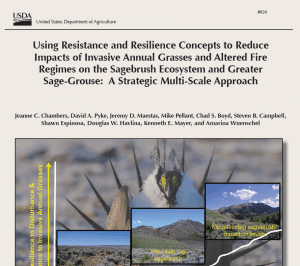Sagebrush
View report.
This final report includes actions to be implemented by Interior’s bureaus to immediately address the threat of rangeland fire and other disturbances to Western sagebrush-steppe landscapes and improve fire and fuels management efforts.
View guide.
In this study, researchers modeled the climatic envelope for subspecies wyomingensis for contemporary and future climates (decade 2050). Comparison of the contemporary and decade 2050 models shows a predicted 39% loss of suitable climate. Much of this loss will occur in the Great Basin where impacts from increasing fire frequency and encroaching weeds have been eroding the A. tridentata landscape dominance and ecological functions. The goal of this study is to provide a management tool to promote successful restoration by predicting the geographic areas where climate is suitable for this subspecies.
View fact sheet.
This fact sheet provides land managers with a brief summary of the effects of conifer expansion and infill in sagebrush ecosystems and of potential management strategies.
View report.
The initial report includes actions to be implemented by Interior’s bureaus to immediately address the threat of rangeland fire to Western sagebrush-steppe landscapes and improve fire management efforts before the start of the 2015 wildfire season.
View field guide.
This field guide identifies seven primary components that largely determine resilience to disturbance, as well as resistance to invasive grasses and plant succession following treatment of areas of concern. An evaluation score sheet is included for rating resilience to disturbance and resistance to invasive annual grasses and the probability of seeding success.
View fact sheet.
This fact sheet from the Sage Grouse Initiative discusses a new soils product that provides the ability to depict potential ecosystem resilience and resistance across the range of sage-grouse using soil temperature and moisture regimes.
View report.
This report provides a strategic approach for conservation of sagebrush ecosystems and greater sage-grouse that focuses specifically on habitat threats caused by invasive annual grasses and altered fire regimes. It uses information on (1) factors that influence sagebrush ecosystem resilience to disturbance and resistance to invasive annual grasses and (2) distribution, relative abundance, and persistence of sage-grouse populations to develop management strategies at both landscape and site scales.
Visit SageSTEP website.
SageSTEP is a long-term multidisciplinary experiment evaluating methods of sagebrush steppe restoration in the Great Basin.
You can find and access information on this project’s:
- Land management treatments
- Treatment effects on vegetation and fuels; soils and biogeochemistry; water runoff and erosion; wildlife and insects
- The economics and human perspectives of management treatments
- Association with climate change
- Research findings thus far and project future
View report.
This report, developed by the Western Association of Fish and Wildlife Agencies (WAFWA), Wildfire and Invasive Species Initiative Working Group (Working Group), summarizes the current state of Fire Operations and Fuels management functions in big sagebrush communities. The intent of this report is to illustrate the type and responsiveness of efforts being made. Finally, the report concludes by presenting future options and a series of recommendations that may inform future policy and allocation decisions.
View synthesis.
This synthesis describes what is known about the cumulative impacts of historic livestock grazing patterns and short-term effects of livestock grazing on fuels and fire in sagebrush ecosystems. Over years and decades grazing can alter fuel characteristics of ecosystems. On a yearly basis, grazing can reduce the amount and alter the continuity of fine fuels, potentially changing wildlife fire spread and intensity. However, how grazing-induced fuel alterations affect wildland fire depends on weather conditions and plant community characteristics. As weather conditions become extreme, the influence of grazing on fire behavior is limited, especially in communities dominated by woody plants.



